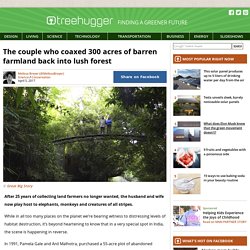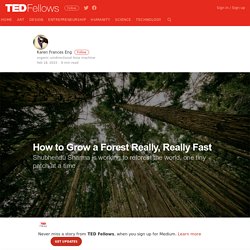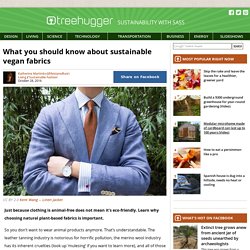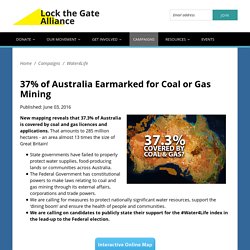

Climate Emergency. Issues. -: Sai Sanctuary :- The couple who coaxed 300 acres of barren farmland back into lush forest. After 25 years of collecting land farmers no longer wanted, the husband and wife now play host to elephants, monkeys and creatures of all stripes.

While in all too many places on the planet we’re bearing witness to distressing levels of habitat destruction, it’s beyond heartening to know that in a very special spot in India, the scene is happening in reverse. In 1991, Pamela Gale and Anil Malhotra, purchased a 55-acre plot of abandoned farmland in India’s Southern Ghats, as we wrote about last year. From there they slowly began purchasing more parcels of barren land where rice, coffee and cardamom once grew. How to Grow a Forest Really, Really Fast – TED Fellows. Back in 2008, I was an industrial engineer at Toyota in India, helping prepare assembly lines and dispatch systems for car manufacture.

One day, a scientist named Akira Miyawaki came to the factory to plant a forest on Toyota’s campus. He gave a presentation on his methods, and I became so fascinated that I decided I wanted to learn how to plant a forest myself. Miyawaki is quite famous, and very old; he’s now 87. He has planted around 40 million trees all over the world, and in 2006, he won the Blue Planet Prize, the equivalent to the Nobel Prize in the environmental field. What you should know about sustainable vegan fabrics. Just because clothing is animal-free does not mean it's eco-friendly.

Learn why choosing natural plant-based fabrics is important. So you don’t want to wear animal products anymore. That’s understandable. The leather tanning industry is notorious for horrific pollution, the merino wool industry has its inherent cruelties (look up ‘mulesing’ if you want to learn more), and all of those products are taken without animals’ permission, which can really rankle some people.
It is important to realize, however, that a switch to vegan clothing does not automatically mean a switch to greener clothing. Trees can form bonds like an old couple and look after each other. A forester and scientist have been studying communication between trees for decades; their incredible observations can be seen in the new documentary, 'Intelligent Trees.' Trees have feelings.

They can feel pain, but can also have emotions, such as fear. Trees like to stand close together and cuddle. There is in fact friendship among trees. Magnificent time-lapse film shows tiny movements of corals up close (Video) Over the last few decades, scientists have been sounding the alarm about the Great Barrier Reef, which has lost more than a quarter of its corals in the last three decades, due to bleaching brought on by climate change, storms and coral-munching starfish -- and quite possibly even sunscreen.

But while the statistics are sobering, they are nevertheless dry, and don't hold the same punch as if you saw visual evidence of how truly beautiful and fragile corals are, and how precarious their plight. To raise awareness about the dangers corals worldwide like those of the Great Barrier Reef are facing, Barcelona-based film production company myLapse chose to create this magnificent time-lapse video of corals in motion and close-up: coral colors from myLapse on Vimeo. © myLapse © myLapse According to This Is Colossal, myLapse used over 25,000 images of various corals taken over the course of a year, stitching them together to show movement. Map Australian of coal and gas. New mapping reveals that 37.3% of Australia is covered by coal and gas licences and applications.

That amounts to 285 million hectares - an area almost 13 times the size of Great Britain! State governments have failed to properly protect water supplies, food-producing lands or communities across Australia.The Federal Government has constitutional powers to make laws relating to coal and gas mining through its external affairs, corporations and trade powers.We are calling for measures to protect nationally significant water resources, support the ‘dining boom’ and ensure the health of people and communities.We are calling on candidates to publicly state their support for the #Water4Life index in the lead-up to the Federal election.
At risk are many nationally significant water resources, including: We Must Choose Between The Devil And The Deep Blue Sea. Madrid Statement On Fluorochemicals. The Madrid Statement documents the scientific consensus regarding the persistence and potential for harm of poly- and perfluoroalkyl substances (PFASs), and lays out a roadmap to gather needed information and prevent further harm.

It was published in the May 2015 issue of the journal Environmental Health Perspectives. Click here to sign Photo credit: Flickr @ Turismo Madrid The Madrid Statement on Poly- and Perfluoroalkyl Substances (PFASs) As scientists and other professionals from a variety of disciplines, we are concerned about the production and release into the environment of an increasing number of poly- and perfluoroalkyl substances (PFASs) for the following reasons: PFASs are man-made and found everywhere. Global action through the Montreal Protocol[29] successfully reduced the use of the highly persistent ozone-depleting chlorofluorocarbons (CFCs), thus allowing for the recovery of the ozone layer. A. B. EWG Guide to PFCs. The big green furphy: experts bust degradable plastic bag myth.